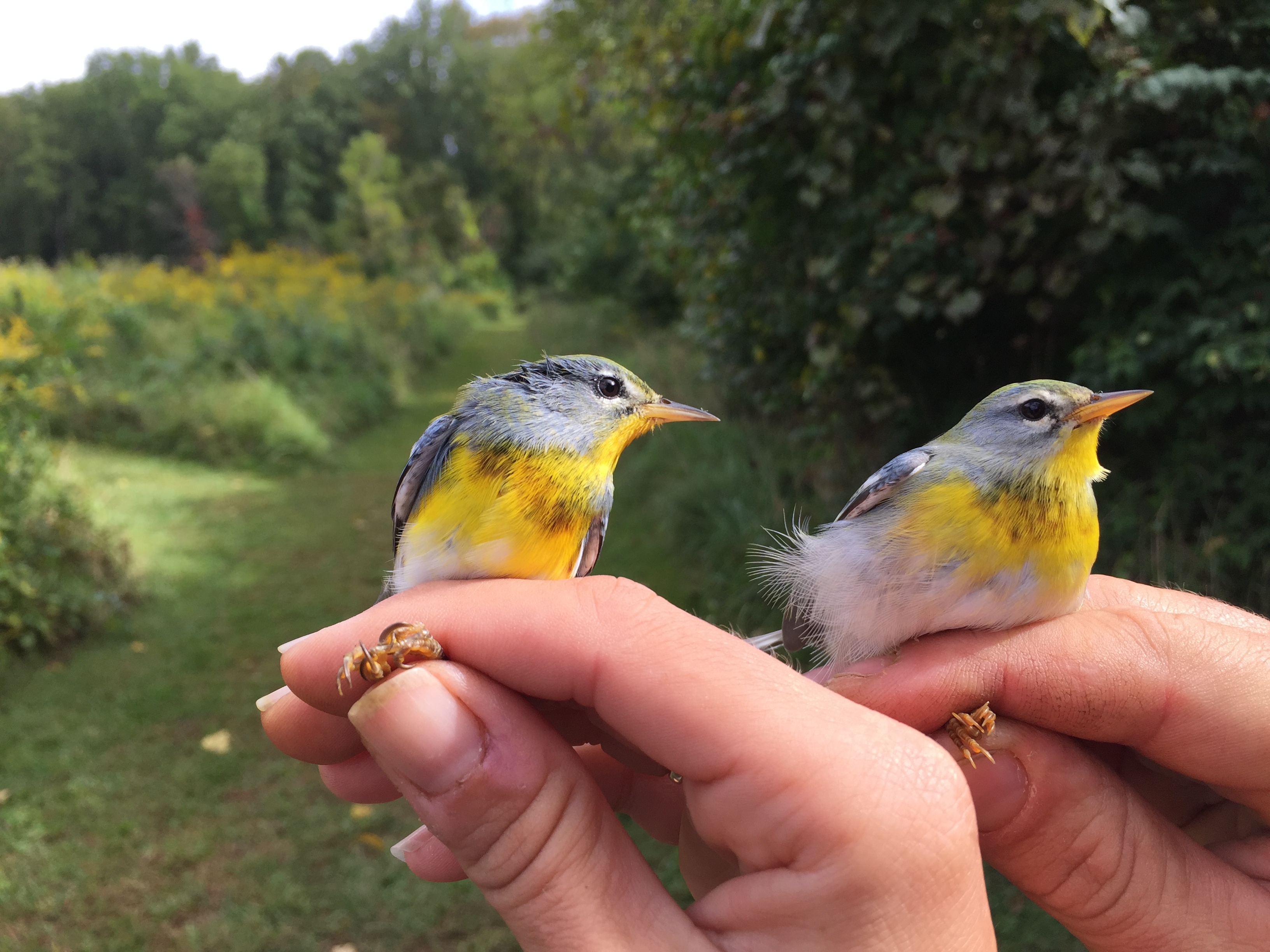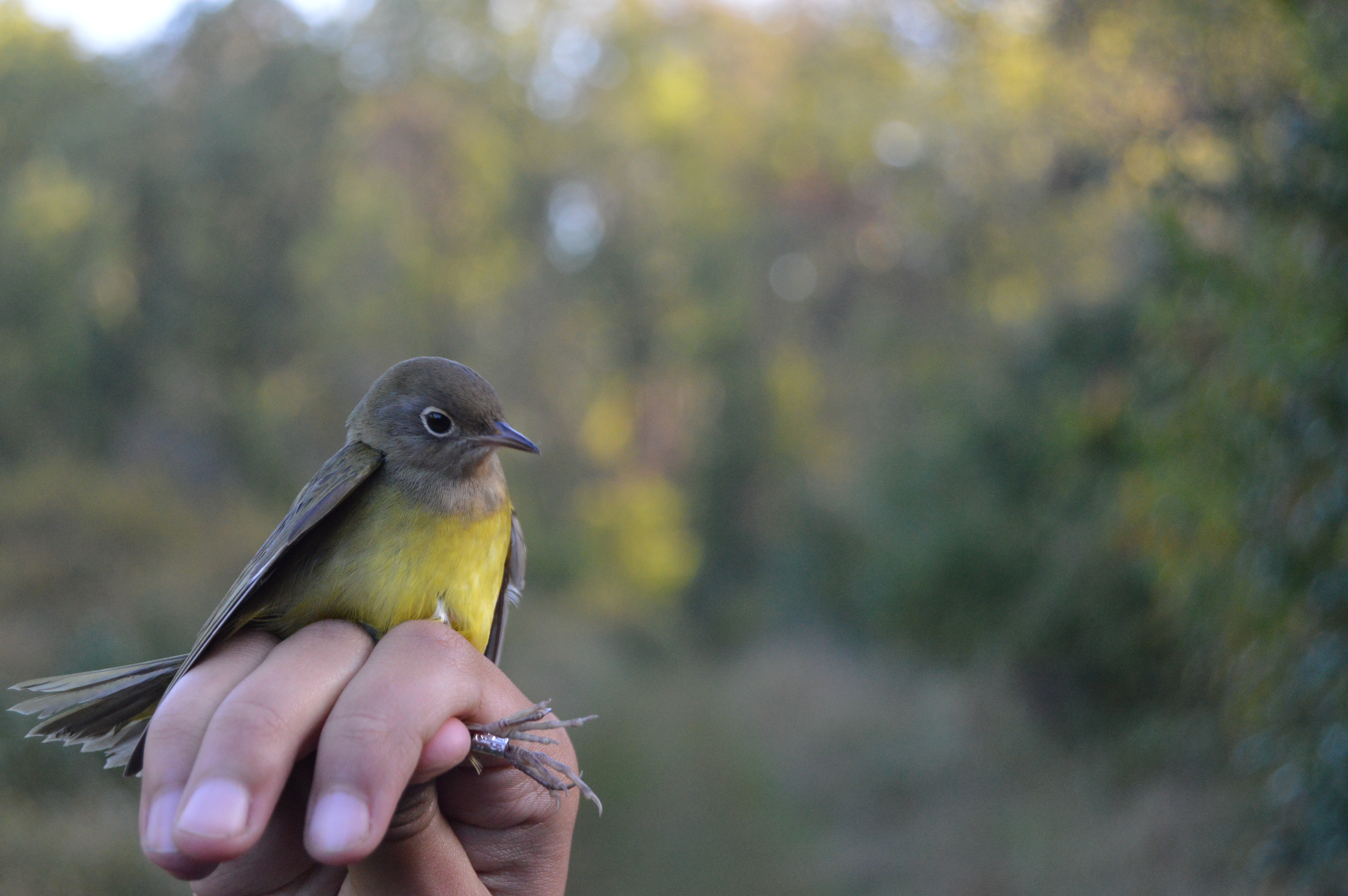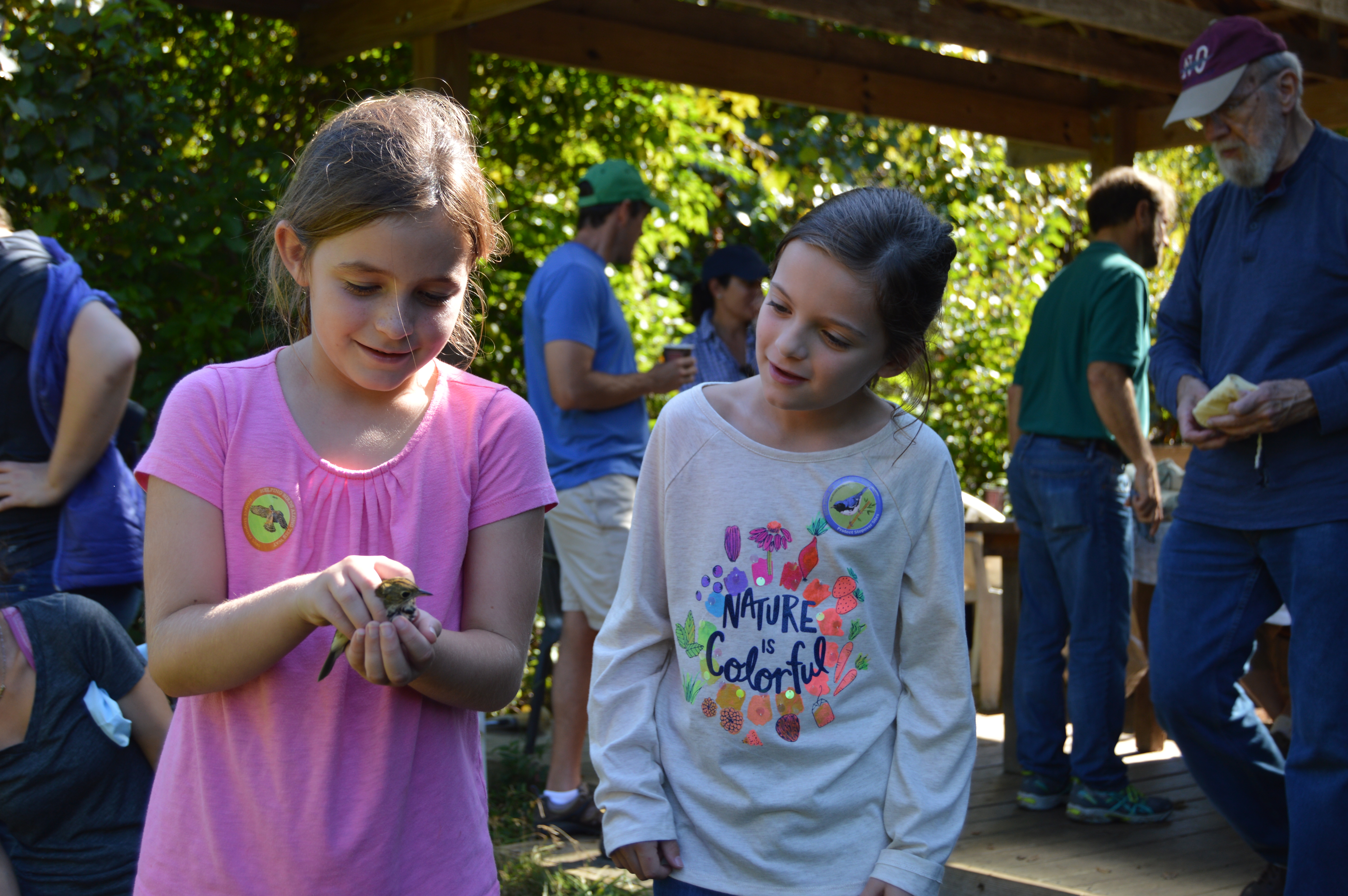
I like winter. As December rolls around and the snow sparkles and swirls outside my window, I have no choice but to stay inside and reflect on the year. And what a year the Rushton banding crew has had, with wonderful memories galore to keep us warm as the icicles fall.





The elusive Connecticut Warbler showed up on the 5th of October, a whole month later than its usual autumn debut at Rushton, possibly because of the wild and wacky fall weather. It was a balmy 60 degrees on that morning whereas a few days prior the mercury started out in the 40’s, chilly enough for the crickets to wait until much later in the day to pick up their strings.
Warbler numbers at Rushton always seem a bit more depauperate each year, but especially noticeable has been the decrease in our Black-throated blue catch with only eight individuals banded this fall. Does this indicate a decline in this species or are they simply not using Rushton as a stopover site? One window collision study has shown that this particular warbler is among the “super-colliders”, a few species that for whatever reason have a higher rate of mortality from communication towers. Could this be why we see less of them? On a positive note, thanks to the independent research of a single mom named Joelle Gehring, the Federal Communications Commission has approved changes that save birds without reducing air safety, i.e., removing steady burning lights from communication towers to reduce bird mortality by 70%.


Another disappointingly underrepresented species this year at Rushton was the Northern Saw-whet Owl. In seven weeks of owl banding we only captured 12 saw-whets. To be fair, we were expecting this since every other year is a good year for this cyclical species, which is essentially tied to the natural seed production of the boreal forest. Last year, we banded 95 saw-whet owls.
When the trees have a good year, the seed collecting mice have a banner year and the mouse munching owls make out. This past breeding season was poor for the saw-whets, likely because the trees did not give a mouse a cookie. As a result of few new baby owls competing for food combined with mild weather in the Northeast this fall, most of the adult owls did not feel like migrating. A great example is the one foreign recovery we had this year; an owl we banded last year around the traditional peak of saw-whet owl migration (end of October/beginning of November) was picked up in Canada about that same time this year, with no indication of any migratory itch.

Going back to our review of songbird banding, the age ratio of our catch this fall was, as usual, heavily skewed toward Hatch Year (birds in their first fall)— a whopping 86 %. Compare that to our spring, which typically consists of only about 60 % of these young birds, mostly due to the fact that many young birds do not make it through that first fall migration, thanks in part to what we’ll call anthropogenic complications.
At Rushton, we’re just helping to monitor the birds while encouraging people to learn about them. Birds are the global heartbeat. “As we learn about birds we learn about ourselves and the planet”, says John Fitzpatrick, Director of Cornell Lab of Ornithology. They teach us how to manage habitat and ecosystems, and they teach us how our actions affect Earth. Unfortunately, as the human population has doubled in the past 50 years, bird populations have declined by 50 percent. Habitat loss and urban sprawl have taken the worst tolls, especially on our neotropical species whose great migrations bring them up against even more human perils.

One-third of North American bird species need urgent conservation to avoid extinction. One way to expedite bird conservation is to learn faster about where they are going. This is where the peculiar tower atop the Rushton greenhouse comes into play. It is the first of a line of 20 automated radio telemetry receiver stations that now stretches across Pennsylvania from the Southeast to Lake Erie.
This array is part of the new cutting edge wildlife tracking technology called Motus that — although has only been around for a few years — has managed to generate over 350 million data hits from 350 receiving stations in the western hemisphere, putting it on track to be one of the world’s largest collaborative research and conservation efforts. The system uses the world’s smallest transmitters called nanotags that can be made tiny enough to sit on the back of a monarch butterfly during its migration.

Below is Bird Studies Canada’s spectacular new YouTube video about the Motus Wildlife Tracking System. In addition, Scott Weidensaul, author and naturalist, elaborates on Motus in our Sycamore newsletter here.
The line of Motus towers across PA (which was mostly erected in just 17 days this summer) was the work of the Northeast Motus Collaboration, an impressive new partnership including Willistown Conservation Trust, Ned Smith Center for Nature and Art, Project Owlnet and Bird Studies Canada. It represents the first statewide effort of its kind. The towers are already revealing important information that traditional banding simply cannot; birds we never knew flew through PA indeed do, including Whimbrels and even a Yellow-headed Blackbird. Specifically our tower at Rushton has recorded nocturnal pings from tagged flyovers including many Redknots (a federally threatened shorebird), King Rails, Gray-cheeked Thrush from Colombia and even Silver-haired bats.





Such sophisticated tracking technology is unveiling the migratory stopover sites and routes that birds use. This knowledge is vital to saving habitat in today’s world where energy infrastructure and development projects seem to pop up any and everywhere. For example, the enigmatic Connecticut Warbler has recently been confirmed by Motus research as a seafarer much like the Blackpoll Warbler, traveling between one and two thousand miles over the merciless Atlantic Ocean from the Northeast. They eventually ride the tradewinds southwest over Bermudan airspace directly into Cuba, Haiti or the Dominican Republic after two days of ocean flight.
Evidently, Connecticut warblers use the Caribbean as stopover habitat along the ocean flyway before continuing on to the Amazon rainforest for the winter. So you see, not only is it important to focus conservation efforts for this particular species in the Amazon but also in the newly revealed Caribbean hideout.

As Joe Smith referenced in his excellent blog for Nature.org, Columbus and his voyagers once followed “the great flocks of birds” that were flying over the ocean toward the Caribbean Islands during the peak of fall migration. Though we may never know how great the great flocks of 1492 surely must have been, we can hope that Motus will help us preserve some of the migratory magnificence that has forever been one of Earth’s most awe-inspiring cycles.
Please enjoy the following collection of photos from autumn at Rushton with excerpts from our daily banding reports:
August 31st: This morning marked the dawn of another new autumn in Rushton Woods. Well seasoned banders arose expectantly minutes before their alarms went off and reported for duty at civil twilight in the heavy wet morning.

As the great Doris McGovern once said in one of her renowned banding reports, “what a privilege to be a part of the cycles of the natural world.” Indeed, it feels like an honor to call Rushton our office in which we experience and monitor one of the world’s greatest phenomena from late August until November: the migration of billions of songbirds to their southern wintering grounds.




November 2nd: Today was unseasonably warm for November making the White-throated Sparrows and juncos seem out of place. The soundscape resembled an aviary with dozens of robins chattering in the canopy, some singing as though it were spring. We also delighted in one more each of our favorite birds: the Golden-crowned Kinglet, Fox Sparrow and Winter Wren.














